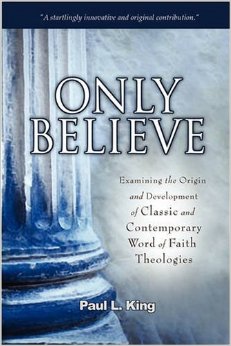Paul L. King: Hermeneutics in Modern and Classic Faith Movements
If we want to live our lives according to the Bible, how we approach Scripture means everything. What differences in interpretation can we see between the contemporary Word of Faith movement and the classic Faith movement?

This chapter is from Paul L. King’s book Only Believe: Examining the Origins and Development of Classic and Contemporary Word of Faith Theologies.
Many, perhaps even most, of the controversies regarding contemporary faith theology and practice have involved the interpretation of various passages of Scripture. Regarding the “health and wealth gospel,” Fee affirms: “The basic problems here are hermeneutical, i.e., they involve questions as to how one interprets Scripture. Even the lay person, who may not know the word “hermeneutics’ and who is not especially trained in interpreting the Bible, senses that this is where the real problem lies. The most distressing thing about their use of Scripture … is the purely subjective and arbitrary way they interpret the biblical text.”1
Hermeneutics and the Contemporary Faith Movement
James W. Sire, in his book Scripture Twisting, addresses ways in which cults misuse the Scriptures: inaccurate quotation, twisted translation, ignoring the immediate context, collapsing contexts of two or more unrelated texts, speculation and overspecification, mistaking literal language for figurative language (and vice versa), selective citing, confused definitions, ignoring alternative explanations, among others.2 Many of these misuses of Scripture in the contemporary faith movement have been pointed out by their critics. However, this does not mean that the contemporary faith leaders are cultic as some have claimed them to be, but it does demonstrate that there is a serious problem with some contemporary faith exegesis.
There is a serious problem with some contemporary faith exegesis.
This is nobly said; but what does it mean? Implied is the hint that interpretations that differ from his are based on what people think, not on what the Bible says. But also implied is the truth that good interpretation should begin with the plain meaning of the text. The plain meaning of the text, however, is precisely what Copeland and the others do not give us, text after text. … But “plain meaning” has first of all to do with the author’s original intent, it has to do with what would have been plain to those to whom the words were originally addressed. It has not to do with how someone from a suburbanized white American culture of the late 20th century reads his own cultural setting back into the text through the frequently distorted prism of the language of the early 17th century.4
To illustrate Fee’s apprehension, a popular saying in the contemporary faith movement proclaims, “God said it; I believe it; and that settles it.” That statement is true as far as it goes. But it leaves something out: what is it that God really said, and what does it mean? Often this is presumed, rather than thought through and studied exegetically. Lovett, formerly a professor at Oral Roberts University, also writes of his concern, explaining, “The problem with exponents of the Rhema [word of faith] interpretation is their biased selection of biblical passages, often without due regard to their context. The self-defined phrase ‘confessing the Word of God’ takes precedence over hermeneutical principles and rules for biblical interpretation. This approach not only does violence to the text but forces the NT linguistic data into artificial categories that the biblical authors themselves could not affirm.”5 Simmons concludes that the shaky hermeneutical foundation of the contemporary faith movement stems from its acknowledged founder: “In Kenyon’s hands, even the texts that were a major focus of Keswickeans in general proved to be remarkably elastic. … Kenyon’s tendency was to stretch a term or metaphor to a literal extreme that the original word or figure of speech did not intend.”6
Category: Church History, Pneuma Review, Summer 2012


